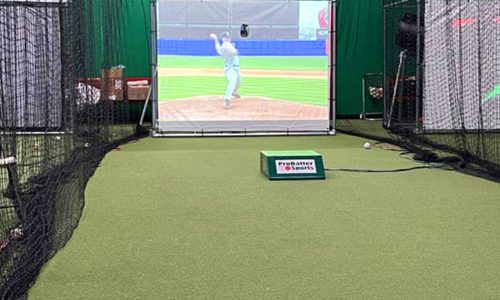Batting Cages: Entering a New Era?
The rhythmic ping of aluminum bats has long resonated from batting cages at ballparks worldwide. For generations, these rudimentary enclosed nets allowed hitters to hone their swings against bowling machine fastballs.
While effective practice tools, traditional batting cages offer limited training compared to live pitching. Now, technological innovation is poised to transform these specialties into sophisticated training systems.
Integrating video simulation, data analytics, variable pitch speeds and types, and interactive programming enables cutting-edge batting cages to provide game-realistic training. With advanced systems like ProBatter’s PX3 Simulator, batters face life-like pitching in simulated game scenarios, getting granular feedback on performance. As technology reshapes athletics, could the tried-and-true batting cage become the training ground of the future?
Evaluating how new capabilities enhance hitting skills, mechanics, and mental game offers insight into how high-tech cages can optimize preparation for on-field excellence. For players looking to gain an edge, the past and future of batting training may converge in revolutionary new systems melding tradition with innovation.
The Traditional Batting Cage
Batting cages first emerged in the 1950s as enclosed netted spaces with manual pitching machines. Players would use these minimalistic setups to practice hitting repetitions without having to retrieve balls. Over the 1970s-90s, cages evolved to use more automated machines, speed adjustments, and durable netting.
Regardless of the level of play, batting cages became essential for skills training. Local community cages helped novice players work on technique. At the professional level, teams relied on cages for conditioning and keeping players’ swings sharp during off-seasons. The core function – maximizing quality batting practice – remained integral across all formats.
From little leagues to the MLB, conventional batting cage facilities retained their fundamental structure – protective netting, pitching machines, and open spaces. Their simple yet practical nature made them ubiquitous in baseball culture.
The Tech-Powered Modern Cage
While traditional cages continue to retain relevance, contemporary versions are stepping up innovations. Modern batting cages infuse sensor-based analytics, video projections, speed variances, and even virtual simulations to amplify benefits.
Cutting-edge programmable pitching machines can now mimic specific pitches with precise control variations. Multi-angle high-speed cameras provide granular frame-by-frame swing analysis through software. Simultaneously, integrated displays give instant visual feedback to players while training.
Some facilities even incorporate augmented reality to simulate game-like conditions. Players wear VR headsets transporting them onto a virtual baseball field while cameras capture their natural motions in the cage. The computer generates gameplay vision including simulated pitchers, fielders, and crowds for profoundly immersive training.
Such technologization maximizes skill refinement within safe practice environments for all levels. It brings measurability, versatility, and fun – catalyzing player development.
The Rise of Smart Batting Cages
As innovations accelerate, ‘smart’ batting cages are emerging as the ultimate baseball training ecosystem. They utilize sensors across equipment and integrate advanced data analytics for tangible improvement.
Smart cages feature radar tracking sensors on balls and bats to provide powerful swing/ball-flight analytics. Impacting factors like launch angles, bat speeds, and precision are charted in real-time through the integrated software. It brings an evidence-based approach to perfect hitting mechanics.
For fielders, advanced ball dispensers can mirror real-game hits to practice reaction times. Smart wearables also monitor fielding intensities, footwork rates, and readiness through biometric data. It optimizes defensive preparedness while preventing potential injuries.
All these smart cage technologies generate actionable performance metrics for players. Coaches benefit by planning training regimens backed by tangible patterns and trends. Over time, intelligence benefits all facets of game development.
Blending Entertainment with Training
To attract new audiences beyond youth leagues and local teams, owners are reinventing cages as entertainment destinations. Contemporary batting cage centers double up as theme parks, arcades, or fantasy sports arenas beyond just skill building.
Some facilities embed cages within competitive interactive games among players, leveraging automatic scoring systems. Others adopt creative themes around sports simulations that groups can enjoy together. Corporate teams may use such special batting cages for team-building activities, mixing engagement with practice.
Such entertainment-infused cages marry fun elements with serious batting training. Through theme-based family entertainment, such facilities make the sport more welcoming and accessible to broader public groups. They expose new participant groups to baseball as a pastime.
The Accessibility Push
As batting cages advance technologically, there is also a parallel movement around accessibility and inclusivity. Smart cages are no longer limited to just within league stadiums or elite training centers. Retail outlets, community recreation facilities, malls, and other public spaces are adding compact VR-based batting cages.
With intuitive instruction mechanisms and adaptive device settings, modern cages support wider skill levels and audiences. Senior citizens, persons with disabilities, and female players have more opportunities than before to try batting practice.
Some training providers also offer special programs on women’s, seniors, and kids’ skill development programs leveraging such accessible cages. Outreach initiatives by teams and leagues further encourage players from disadvantaged neighborhoods to access these facilities.
Technological impetus now allows batting cages to catalyze inclusion along with better training.
The Future of Batting Practice
As innovations continue, what does the future of batting cage training look like? One can expect integration with advanced simulation, AI-based analytics, and customized feedback solutions.
Virtual, augmented, and mixed reality will recreate hyper-realist scenarios beyond physical equipment limitations. Smart wearables may provide in-motion swing adjustments through haptics and biomechanics. With 5G and edge computing, cloud-connected cages could enable remote coaching and tips from the best experts worldwide.
While the core purpose remains skill enhancement through repetition, technology infusion can exponentially magnify benefits for players of all levels. As batting cages get smarter, player development is bound to reach new peaks through more immersive, measured, and adaptive practice. It might just create a new generation of versatile, complete batters.
Conclusion
Batting cages have come a long way from being enclosed net tunnels for basic practice. While traditional cages continue to be relevant, contemporary versions are enriching the experience through sensors, simulations, and connectivity. Smart cages and entertainment solutions are also making the format more engaging, visitor-friendly, and inclusive.
As tech innovations shape new possibilities, they provide a reason for players, coaches, and baseball fans to be excited. There could be significant transformations in how future generations train, adapt, and excel at the game with such an evolved infrastructure. Batting cages seem poised to enter an all-new era!




